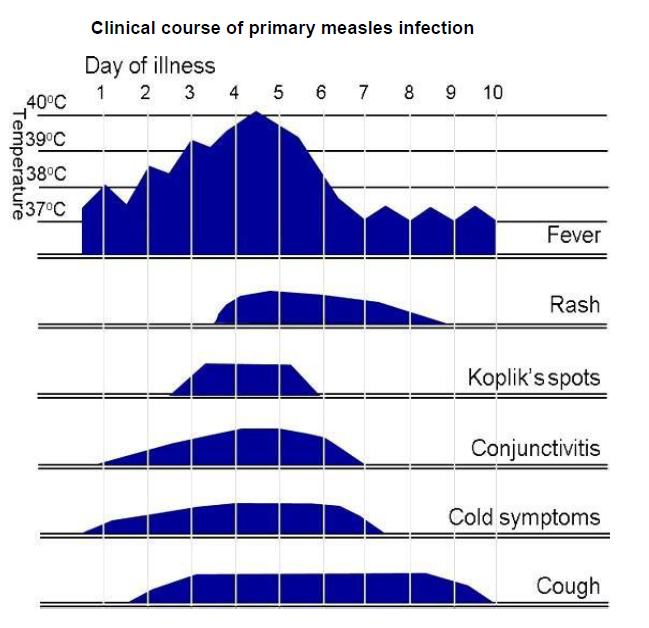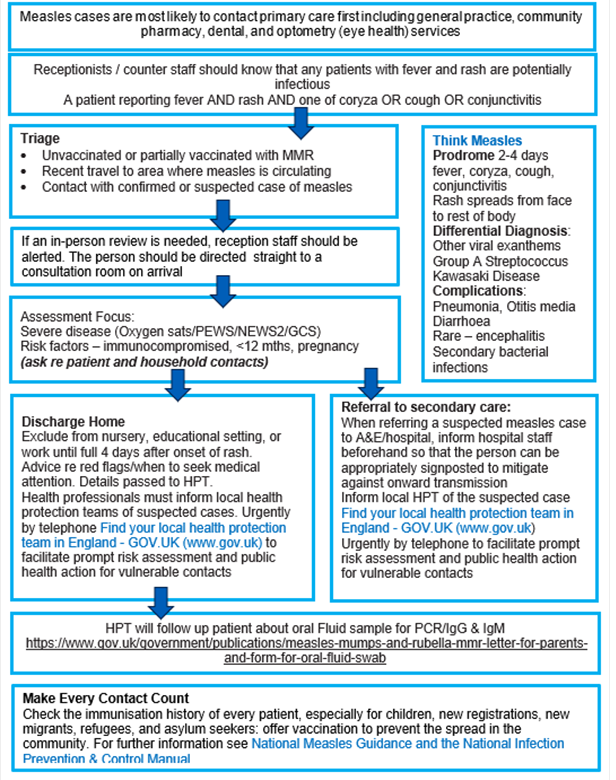Measles
Measles is one of the most highly communicable infectious illnesses caused by an RNA paramyxovirus, with a morbidity and mortality underestimated by the general population.
- prodromal stage is characterised by the onset of fever, malaise, coryza, conjunctivitis and cough
- rash is erythematous and maculopapular, starting at the head and spreading to the trunk and limbs over three to four days
- Koplik spots (small red spots with blueish-white centres) may appear on the mucous membranes of the mouth one to two days before the rash appears and may be seen for a further one to two days afterwards
Measles is spread by airborne or droplet transmission
Individuals are infectious from the beginning of the prodromal period (when the first symptom appears) to four days after the appearance of the rash
The incubation period is about 10 to 12 days from exposure to onset of symptoms; with a further two to four days before the rash appears
- however the incubation period can vary from 7 to 21 days (3)
If a child has the following features then these are strongly suggestive of measles:
- rash for at least three days, and
- fever for at least one day, and
- at least one of the following - cough, coryza or conjunctivitis
It is severe in infants, adults and immunocompromised patients (2).
Measles is a notifiable disease in the UK (since 1940). Notification can be done on clinical suspicion (laboratory confirmation not needed) (1).
Click here for example images of this condition
Click here for "Patient information - What is measles?"
The clinical course of primary measles infection and its main symptoms (3):

NHS England have provided advice regarding possible measles cases presenting to primary care (4):

Notes:
- though transmission route of measles is mostly airborne by droplet spread or direct contact with nasal or throat secretions of infected persons; much less commonly, measles may be transmitted by articles freshly soiled with nose and throat secretions, or through airborne transmission with no known face-to-face contact (3)
- measles is extremely infectious, with a basic reproduction number (R0) estimated around 15 to 20 (that is, on average, there will be 15 to 20 individuals infected from a single case in a totally susceptible population) (3)
- the secondary attack rate is highest among close unimmunised contacts, particularly household contacts
Reference:
- (1) Immunisation Against Infectious Disease - "The Green Book".Chapter 21 Measles (August 2019)
- (2) Asaria P, MacMahon E. Measles in the United Kingdom: can we eradicate it by 2010? BMJ. 2006;333(7574):890–895
- (3) UK Health Security Agency (February 2024). National measles guidelines
- (4) NHS England (January 19th 2024). Guidance for risk assessment and infection prevention and control measures for measles in healthcare settings.
Related pages
Create an account to add page annotations
Annotations allow you to add information to this page that would be handy to have on hand during a consultation. E.g. a website or number. This information will always show when you visit this page.